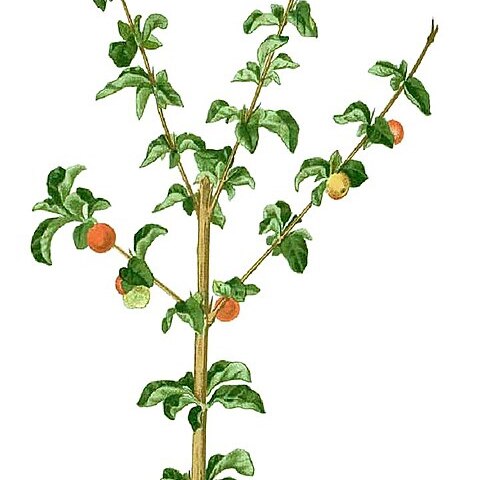Shrubs, 2-3 m tall; branches flattened to subterete, often rather slender, strigillose to strigose or pilosulous, sometimes with lateral short shoots to 0.5 cm; thorns slender to stout, 3-30 mm, straight, or sometimes absent. Leaves paired along developed stems or sometimes clustered on lateral short shoots; petiole 2-3 mm, strigillose to pilosulous; blade drying papery, ovate to lanceolate or elliptic, 2-6 × 1-3.5 cm, adaxially glabrous or strigillose to hispidulous along principal veins or throughout, abaxially puberulent to strigillose or hispidulous, base rounded or obtuse, apex obtuse, acute, or weakly acuminate; secondary veins 2 or 3 pairs, in abaxial axils with pilosulous and/or foveolate domatia; stipules deciduous after distalmost several nodes, triangular to ovate, 2-3 mm, densely strigillose to strigose, acute. Inflorescences fasciculate, 0.5-1 cm, few flowered, strigillose to glabrescent; peduncles 1-3 mm, each with a pair of triangular bracteoles ca. 1 mm and fused in pairs. Calyx puberulent to glabrous; ovary portion obconic, ca. 0.8 mm; limb 0.5-0.8 mm, truncate to undulate. Corolla white, funnelform, outside glabrous; tube suburceolate, ca. 2 mm; lobes 5, triangular-oblong, ca. 3 mm, acuminate. Ovary 2-locular; stigma ca. 0.5 mm. Drupes yellow, ovoid to subglobose, obovoid, or somewhat dicoccous, laterally somewhat flattened, 15-25 × 10-20 mm, smooth, glabrous, with calyx limb persistent; pyrenes 2, weakly tuberculate. Fl. Apr-Jun, fr. Jul-Nov.
More
A spiny shrub. It grows 2-3 m high. It can be a small tree. The young branches are slender. The leaves are opposite and narrowly oval. They are 2-3 cm long by 1-3 cm wide. They taper to the tip and are rounded at the base. The flowers are small and white. They occur singly or as 2 together in the axils of leaves. The fruit are fleshy and 2-3 cm across. They turn yellow as they ripen.

